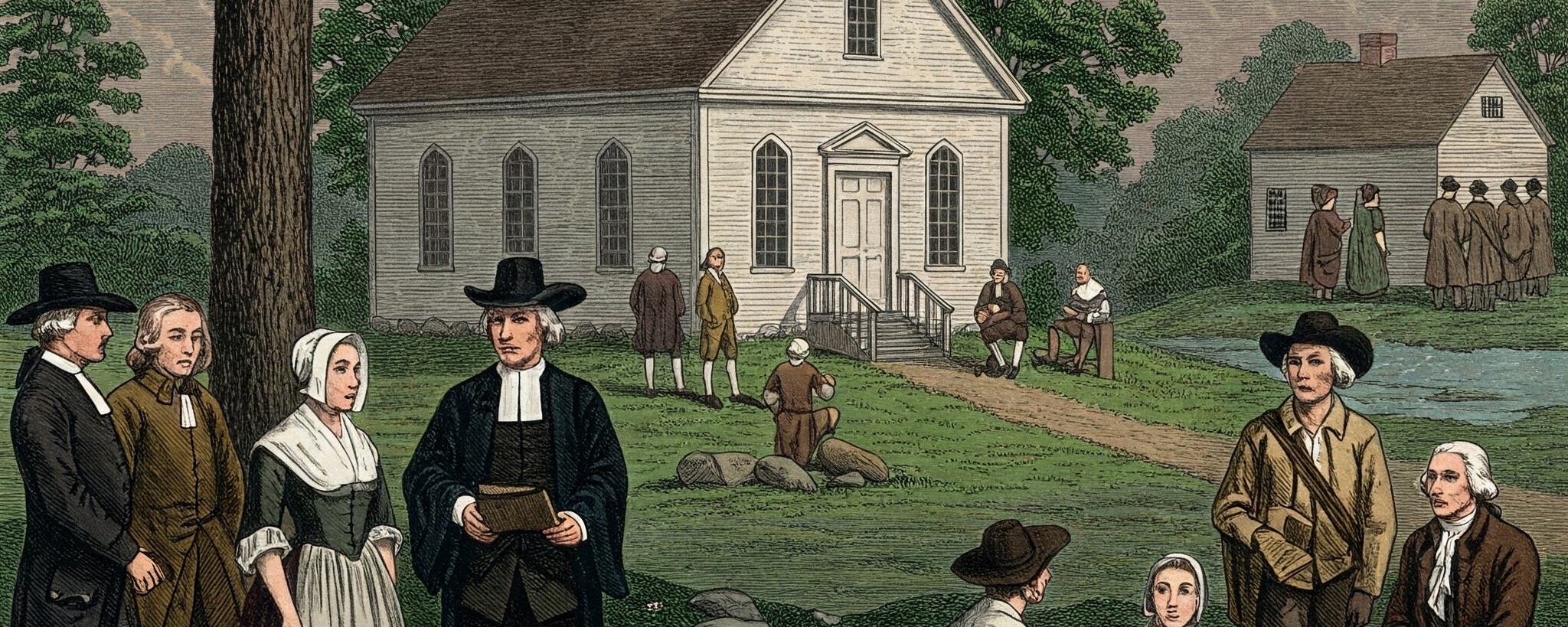The lived religious experience and societal role of 18th-century New England Congregationalism were different from the landscape of modern Protestantism.
To begin, in 18th-century Massachusetts, where Congregationalism was the established church (meaning it was supported by public taxes and held a privileged position), two prominent examples of “dissenting groups” would be:
- Baptists: Key Difference from Congregationalists: Baptists rejected infant baptism, believing that baptism should only be for conscious believers who could make a personal profession of faith. They also strongly advocated for the separation of church and state and religious liberty for all, opposing the system of mandatory taxes to support the Congregational church. Status: They were a growing minority and often faced social and legal pressure, including being taxed for the support of Congregational ministers even if they didn’t attend those churches (though some exemptions were starting to be made by the mid-18th century, they were often hard-won).
- Quakers (Religious Society of Friends): Key Difference from Congregationalists: Quakers had radically different beliefs and practices. They believed in the “Inner Light” (direct, personal experience of God without the need for ordained clergy or formal sacraments), practiced pacifism (refusing to bear arms), refused to swear oaths, and had plain forms of worship, often involving silent waiting. Status: Historically, Quakers had faced severe persecution in Massachusetts in the 17th century (including banishment and execution). By the 18th century, the overt violence had ceased, but they remained a distinct and often marginalized group, facing difficulties due to their pacifism (e.g., during wartime) and their refusal to pay taxes for the established church or participate in other civic rituals that conflicted with their beliefs.
These groups, along with Anglicans (who were a minority in New England though established in England), represented significant religious alternatives to the dominant Congregationalist establishment and played important roles in the long struggle for greater religious freedom in America.
Here is an outline of the differences between Congregationalism and Modern Protestantism:
- Established Church vs. Separation of Church and State: 18th C. Congregationalism (Massachusetts): This was the established church. This meant it was supported by taxes levied on all townspeople (regardless of their personal affiliation, though this was slowly changing for some dissenting groups, like Baptists and Quakers). The church was deeply intertwined with town governance, and ministers often held significant civic influence. There was no concept of “separation of church and state” as we understand it today. Modern Protestantism (e.g., in the US): Operates under a principle of separation of church and state. Churches are voluntary organizations, funded by their members, and there’s a constitutional barrier against government establishment of religion. While religious groups can be influential, they don’t have official, tax-supported status.
- Dominant Theology (Calvinism) vs. Theological Diversity: 18th C. Congregationalism: While the rigors of early Puritan Calvinism had softened somewhat by the mid-18th century (especially after the Great Awakening introduced more experiential elements), core Calvinist tenets like the sovereignty of God, predestination (though debated and nuanced), and covenant theology were still foundational. There was a relatively uniform theological understanding, even with internal debates. Modern Protestantism: Encompasses a vast spectrum of theological beliefs. While Calvinism still exists (e.g., in Presbyterian and some Baptist traditions), Arminianism (emphasizing free will in salvation) is very widespread (e.g., Methodists, many Baptists, Pentecostals). There are also liberal, conservative, fundamentalist, and charismatic wings, each with distinct theological emphases. The sheer diversity is a hallmark.
- Homogenous Religious Culture vs. Pluralistic Society: 18th C. Congregationalism: Society in Massachusetts was overwhelmingly Congregationalist. While other groups existed (Baptists, Quakers, Anglicans), they were distinct minorities and often faced social and sometimes legal disadvantages. Congregationalism shaped the cultural norms, laws (e.g., strict Sabbath observance), and public discourse. Modern Protestantism: Exists within a highly pluralistic religious and secular landscape. There’s no single Protestant cultural dominance in the way Congregationalism had in colonial Massachusetts.
- Corporate/Covenantal Identity vs. Individualistic Emphasis: 18th C. Congregationalism: Still carried a strong sense of a covenanted community – the town and church were seen as bound together in a covenant with God. Membership often involved a public profession of faith and a commitment to the community’s moral and spiritual standards. Modern Protestantism: While community is important, there’s often a stronger emphasis on individual faith, personal salvation experience, and individual interpretation of scripture. The idea of an entire town or state being in a “covenant” with God in the same way is largely absent.
- Worship Style and Liturgy: 18th C. Congregationalism: Worship was generally plain, centered on a long, intellectually rigorous sermon. Hymnody was developing (e.g., Isaac Watts became popular), but unaccompanied psalm-singing was also common. Liturgy was minimal compared to Anglicanism. Modern Protestantism: Worship styles are incredibly diverse, ranging from highly traditional and liturgical (some Lutherans, Anglicans/Episcopalians) to very contemporary with modern music and multimedia (many non-denominational and evangelical churches), to spirited and charismatic (Pentecostal churches). Sermon styles and lengths also vary widely.
- Role of Clergy in Society: 18th C. Congregationalism: Ministers were often among the most educated and respected figures in the community, holding significant moral and intellectual authority, and often playing roles in local governance or as public intellectuals. Modern Protestantism: While clergy are respected within their congregations and some engage in public life, their societal influence is more varied and generally less universally authoritative than their 18th-century counterparts.

